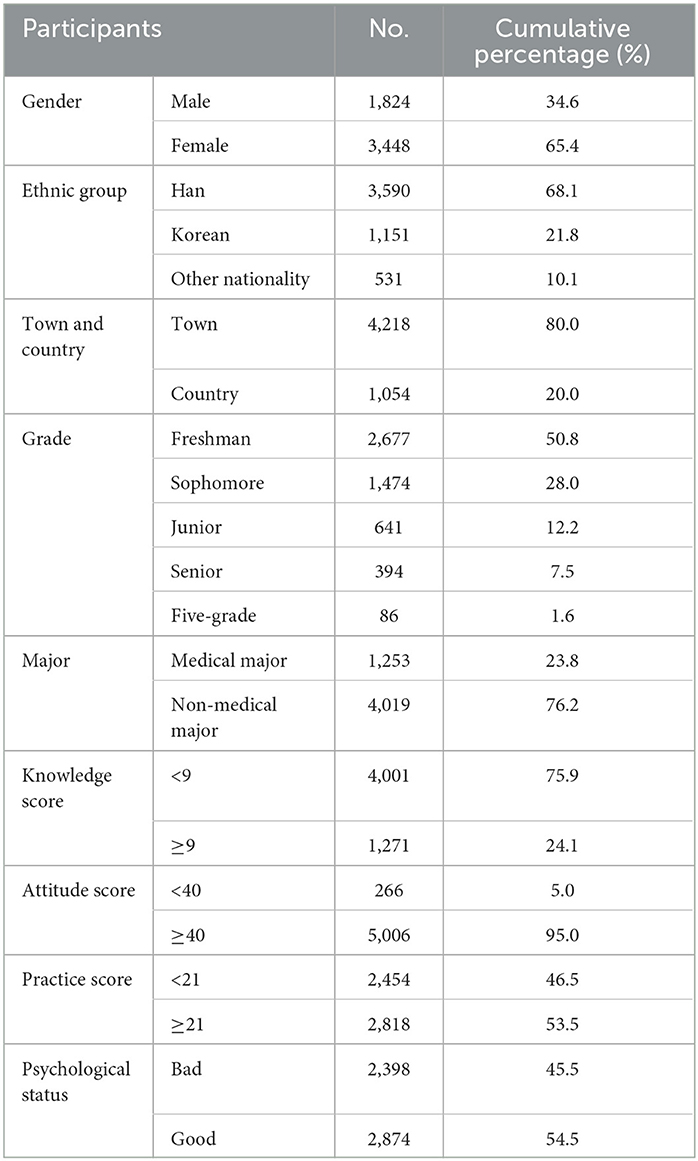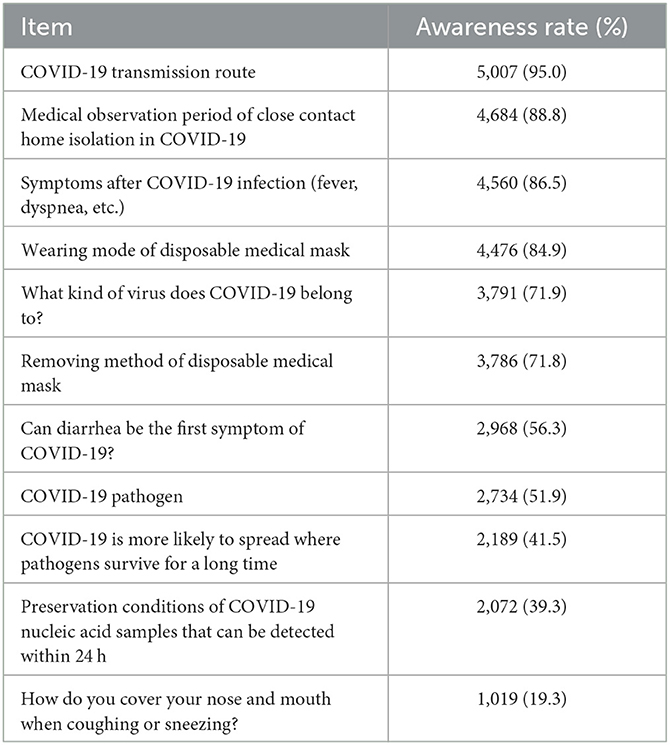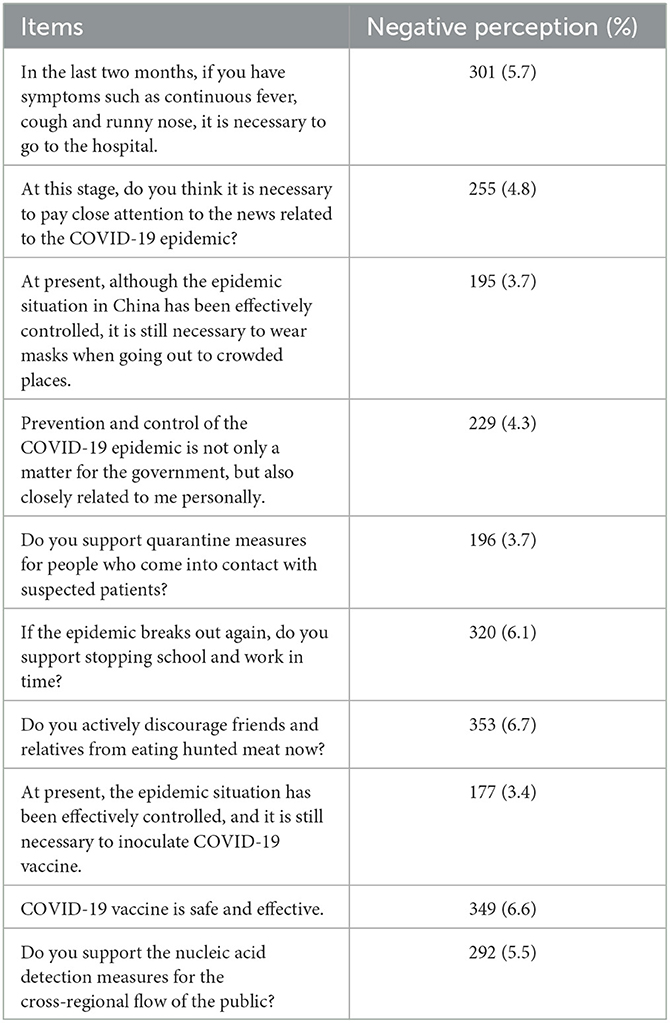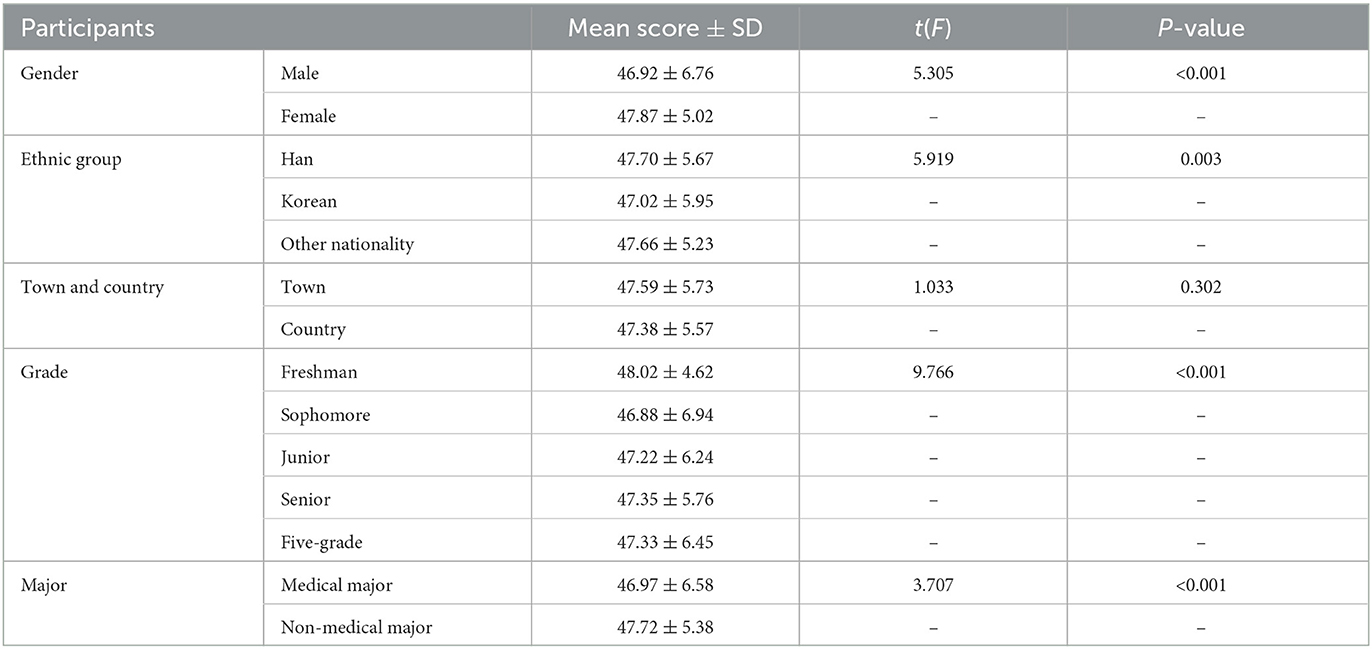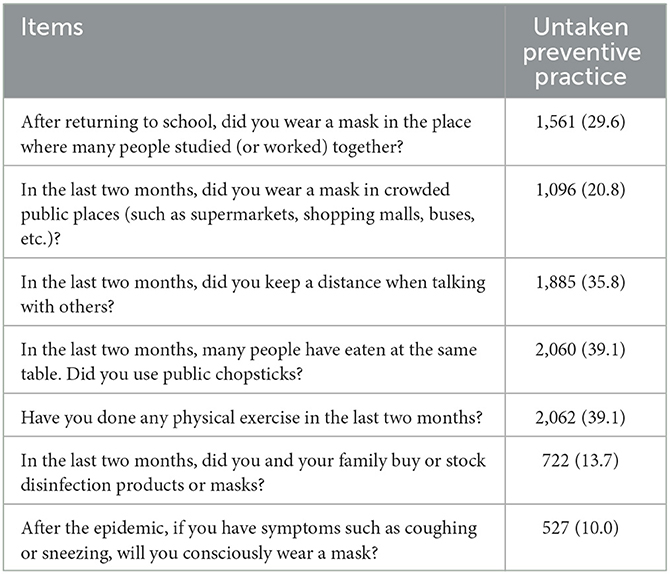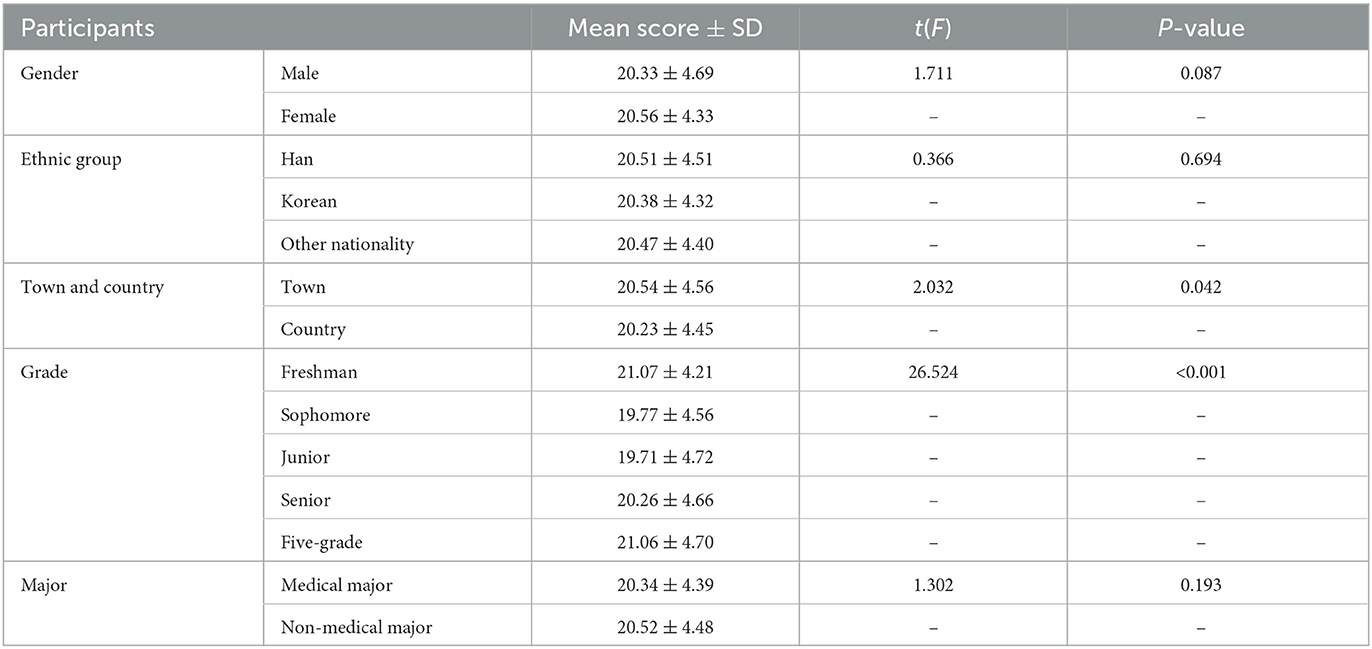- 1Department of Epidemiology, Department of Preventive Medicine, Department of Clinical Medicine, Medical College, Yanbian University, Yanji, China
- 2Education and Scientific Research Office, Chaohanwen College, Yanbian University, Yanji, China
- 3Affairs Management Department, Yanbian University, Hunchun, China
- 4Department of Surgery, Affiliated Hospital of Yanbian University, Yanji, China
- 5Orthopedic Treatment Center of Affiliated Hospital of Yanbian University, Yanji, China
- 6Trauma Center of Affiliated Hospital of Yanbian University, Yanji, China
Background: During the prevalence of coronavirus disease 2019 (COVID-19), little was known about the knowledge, attitudes, practices (KAP) about COVID-19 and psychological status of college students in minority areas. This study aimed to evaluate the KAP of college students in minority areas of China toward COVID-19 and to provide a scientific basis for health education and policy formulation.
Methods: From October 28th to November 6th, 2021, a cross-sectional study was conducted with 5,272 college students to examine KAP and its effects on mental health.
Results: Regarding COVID-19 knowledge, the overall awareness rate was 24.11% (1,271). Regarding health attitudes, most students had positive attitudes about COVID-19 prevention and control (94.95%), and females had higher positive attitudes than males (OR: 1.920; CI: 1.494–2.469). Regarding preventive behaviors, more than half of the students took preventive measures (53.48%), and freshmen had the highest health behavior scores. In terms of psychological status, there were fewer females with depression and stress than males.
Conclusion: College students in minority areas have positive health attitudes; however, their knowledge of COVID-19 prevention and control is low. Moreover, their precautionary behaviors are insufficient, and they have many negative emotions.
Introduction
An outbreak of coronavirus disease 2019 (COVID-19), caused by severe acute respiratory syndrome coronavirus-2 (SARS-CoV-2), occurred in Wuhan, China, in December 2019 and quickly spread worldwide. COVID-19 was listed as a public health emergency of international concern in January 2020 (1). The cumulative number of confirmed COVID-19 cases has reached 763.7 million, with the death toll exceeding 6.9 million, according to the WHO report on 19 April 2023 (2). As of April 19, 2023, a total of 99.2 million people have been diagnosed in China, and 120,912 have died from COVID-19. The strong infectivity, rapid spread, and wide infection range of COVID-19 seriously threatened people's safety and mental health; COVID-19 is one of the major public health emergencies experienced in China in the last hundred years, and its prevention and control present great challenges (3). Mass vaccination has become one of the most important public health policies for countries to prevent the spread of COVID-19. As of March 22, 2023, China has reported providing a total of 3.5 billion doses of COVID-19 vaccine. However, thus far, different variants of SARS-CoV-2, such as the Omicron variant, have been found to spread more widely and faster (4). Higher infection rates caused by mutation confirm that high vaccine coverage may not guarantee effective control of COVID-19 transmission. Therefore, the implementation of outbreak prevention and control measures cannot be ignored, which is closely related to public support (5).
The crisis caused by the COVID-19 pandemic is largely influenced by knowledge, attitudes and practices (KAP) (6). Knowledge, attitudes, and practices (KAP) are important cognitive components of health promotion in public health management, which greatly affects whether people follow preventive strategies and improve their behaviors as early as possible (7–9). Studies have found that knowledge of COVID-19 will affect people's attitudes and practices, while negative attitudes and practices will increase the risk of illness and death (10).
After the initial school closure and self-isolation period, universities reopened on September 7, 2020. However, due to the different severity of the COVID-19 pandemic in different provinces, the specific start time of the universities in different provinces is different (this study was conducted during the beginning of the third vaccination booster shot campaign in China). At present, the school has resumed classes and the order of teaching has been fully restored. The prevention and control of the COVID-19 pandemic on campus is facing new challenges. How to continue to do better in the prevention and control of campus pandemic and reduce the risk of students' physical and mental health affected by the pandemics has become an urgent public health problem (11). Despite daily prevention and control measures, such as maintaining social distance, frequent hand washing, and detecting suspected symptoms, universities were still at risk of outbreaks due to the large number of college students and their strong mobility. According to the statistics of education in 2021, the total number of students studying in higher education in China is 44.3 million. In addition, because it is unregulated, social media can provide misinformation, which can easily lead to ambiguity and misunderstandings regarding COVID-19 and even to panic and confusion (12). Studies have shown that college students' KAP level and mental health are affected by stressful events during the COVID-19 pandemic (13, 14), and the risk of anxiety, depression and other negative emotions among students increases, resulting in increased pressure (15–17). Therefore, good COVID-19-related knowledge, positive attitudes, healthy behaviors and good mental health are essential to effectively prevent and control pandemics and reduce the panic they cause (18–20).
The studied university is located in Yanbian ethnic Korean Autonomous Prefecture, a minority area in China, with 22,487 full-time college students. The time of questionnaire survey is in the normal prevention and control stage after the outbreak of COVID-19 in China. Yanbian University is a minority university and comprehensive university with strong ethnic regional characteristics. At the same time, it has the general characteristics of being a comprehensive university. Compared with universities in other regions, it has strong commonness and certain universality and representativeness. Investigating the knowledge, attitudes and practices of college students during the pandemic period is conducive to further understanding the weak points of pandemic prevention and control awareness in universities, so as to carry out accurate health education and prevention and control. From October 28th to November 6th, 2021, a questionnaire survey was conducted using the “Questionnaires” network platform to evaluate the KAP and mental health status of college students in China minority areas during the COVID-19 pandemic period and to analyze its influencing factors. This study provides a scientific basis for further health education and psychological intervention for college students' COVID-19 prevention and control and helps in the formulation of accurate prevention and control strategies to provide useful experience for curbing similar major public health emergencies in the future. The results are reported as follows.
Materials and methods
Study design
This cross-sectional survey was conducted from October 28th to November 6th, 2021 to evaluate the knowledge, attitudes, and practices about COVID-19 outbreak and psychological status of college students.
Population and data collection
The research subjects were college students from a minority area in China. Considering the limitation of actual status in the sampling design and investigation implementation stage, non-probability sampling (convenient sampling) was adopted to conduct the current survey. Convenient sampling, also known as accidental sampling or natural sampling, is that researchers choose those who are easy to find or obtain information as the investigation objects according to the actual status. Therefore, expanding the sample size as much as possible can reduce the difference between the sample and the population. Therefore, in the implementation stage, this survey included a total of 5,272 large sample data to improve the representativeness of the sample. The effective response rate was 100%.
Referring to the Guide to the Prevention and Control of COVID-19 in Colleges and Universities (21) and authoritative official reports, we created an electronic questionnaire through the online survey platform “Questionnaires” and conducted a presurvey (a total of 300 people). After improving the questionnaire, we conducted a formal online survey through social media platforms (e.g., WeChat) from October 28th to November 6th, 2021. Instructions of the questionnaire on the front page clearly informed the participants of the research purposes and their rights regarding joining or dropping out of this study at any time during participation. All participants were informed and assured that their participation was voluntary, anonymous, and strictly confidential.
Measures
The following tools were used in this study: (1) a general information questionnaire (sex, nationality, urban and rural areas, grade, major, etc.). (2) A self-made COVID-19 KAP questionnaire (COVID-19-related knowledge, attitudes and prevention practices), with 11 knowledge questions, receiving a total score of 11 points. And there are 10 health attitude questions. A 5-point Likert scale was used to measure and evaluate the support of COVID-19 prevention and control (1 = totally disagree to 5 = totally agree), with a total score of 50 points. Regarding health practice, five questions received scores of up to four points, and two questions received scores of up to three points, with a total possible score of 26 points. The study used a score of 80% as the cutoff. In terms of health knowledge, a score of ≥9 was considered high cognition, which was defined as awareness. In terms of health attitudes, a score of ≥40 was classified as positive health attitudes. In terms of health practice, a score of ≥21 was classified as good health behavior. (3) The Depression-Anxiety-Stress Scale (DASS-21) included 21 items divided into three dimensions: Depression, anxiety and stress. A stress scale score of >14 indicated psychological stress, an anxiety scale score of >7 indicated psychological anxiety, and a depression scale score of >9 indicated psychological depression. The scoring method of Bi et al. (22) was used. Those who had depression, anxiety and stress were classified as having negative emotions.
Data analysis
SPSS 26.0 statistical software was used for statistical analysis of the data. Descriptive statistical analysis was performed on the number distribution of college students according to demographic characteristics. The count data are expressed by the composition ratio. Percentage comparisons were tested by binary logistic regression analysis to evaluate the related influencing factors. The variables of influencing factors in the results of logistic analysis are to explain the risk factors that affect the knowledge, attitudes, practices of COVID-19 prevention and control and psychological status among college students. For measurement data comparisons, T-tests were used for two groups and ANOVA was used for three or more groups, as described by[[Inline Image]]. A two-sided test was adopted, with a test level of α = 0.05, and the difference was considered statistically significant when P < 0.05.
Ethical considerations
Informed consent was obtained from all subjects involved in the study. The study was conducted according to the guidelines of the Declaration of Helsinki, and approved by the Institutional Review Board of Yanbian University (Ethical Code: 2021576, October 26th, 2021).
Results
Basic information
A total of 5,272 college students were included in this study, and their general characteristics are shown in Table 1.
College students' awareness of COVID-19
The average COVID-19 prevention and control knowledge score of college students was 7.07 ± 2.01. Regarding college students' knowledge about COVID-19, college students had good knowledge about the attributes of COVID-19 virus pathogens (71.9%) but insufficient knowledge about the pathogens (51.9%). The awareness rate of survival conditions (41.5%) and preservation conditions of COVID-19 nucleic acid test specimens (39.3%) was low. College students (95.0%) had a high degree of knowledge of COVID-19 transmission channels. The awareness rate of symptoms such as fever and dyspnea after COVID-19 infection was good (86.5%); however, the awareness rate of whether diarrhea can be the first symptom of COVID-19 was low (56.3%). College students had poor knowledge of the correct way to cover their nose and mouth when coughing or sneezing (19.3%). The students had good knowledge of the medical observation period of close contact home isolation for COVID-19 (88.8%). The awareness rate of wearing (84.9%) and taking off (71.8%) disposable medical masks was good (see Table 2).
The overall awareness rate of COVID-19 prevention and control knowledge was low, accounting for 24.11% of the sample (1,271 people). Univariate analysis showed that there were differences in the awareness rate of COVID-19 prevention and control knowledge among college students of different genders, grades and majors (P < 0.05), and the results are shown in Table 3. Specifically, females had higher awareness than males. Five-grade students had the highest awareness than students in other grades. Medical majors had significantly higher awareness than non-medical majors.
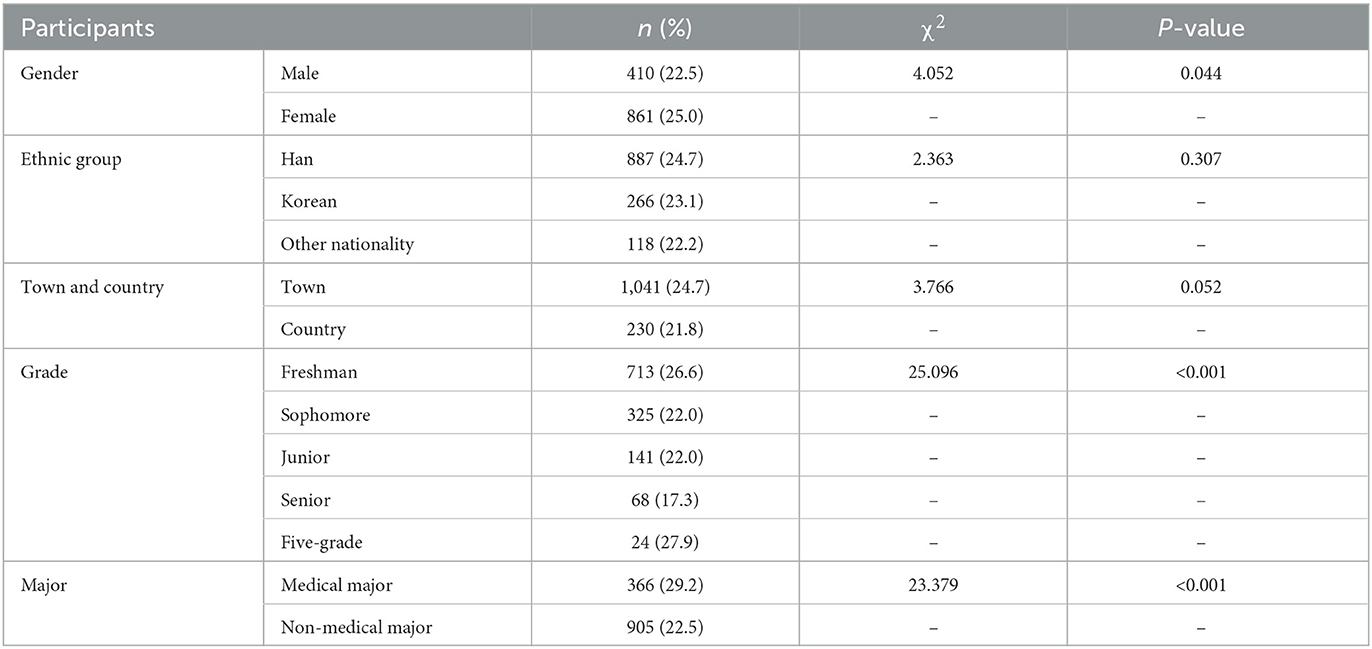
Table 3. Single factor analysis of the awareness rate of COVID-19 prevention and control knowledge among college students.
Logistic regression analysis was performed for the variables with statistical significance in the single factor analysis of the knowledge awareness rate, and the results were consistent with those of the single factor analysis. Multivariate regression analysis showed that females were the protective factors for the high awareness rate of prevention and control knowledge in COVID-19 (OR = 1.172, 95% CI = 1.024–1.341). Compared with freshmen, sophomores (OR = 0.787, 95% CI = 0.677–0.915) and juniors (OR = 0.793, 95% CI = 0.645–0.975) are the risk factors for high awareness (see Table 4).
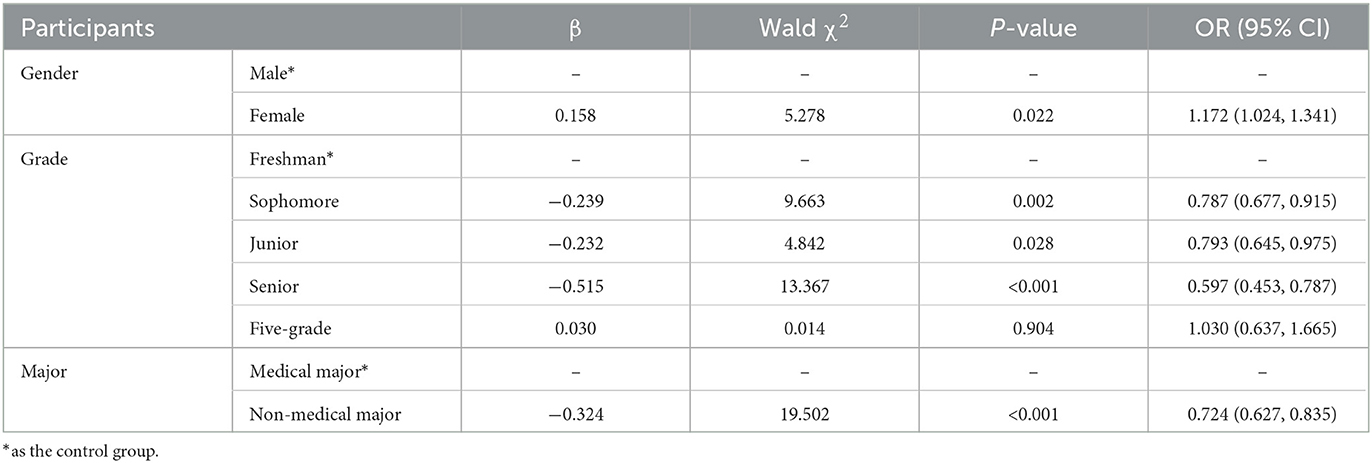
Table 4. Binary logistic regression analysis of influencing factors of COVID-19 prevention and control knowledge among participants (n = 5,272).
College students' attitudes regarding the prevention and control of COVID-19
The average score of college students' attitudes toward COVID-19 prevention and control was 47.54 ± 5.70. More college students in minority areas have positive health attitudes (see Table 5). Univariate analysis showed that there were differences in the scores of COVID-19 prevention and control attitudes among college students of different sexes, nationalities, grades and majors (P < 0.05), and the results are shown in Table 6. Specifically, females had higher attitude scores than males. Students of Han nationality had higher attitude scores than students of other nationalities. Students in their first year had higher attitude scores than students in other years, and those in their second year had the worst attitude scores. Medical majors had lower attitude scores than non-medical majors.
Most college students had positive health attitudes about COVID-19 prevention and control, accounting for 94.95% of the sample (5006). Logistic regression analysis was performed for the variables with statistical significance in single factor analysis of attitude scores, and the results were consistent with those of single factor analysis. Logistic regression analysis showed that females were the protective factors to keep positive perception on prevention and control of COVID-19 (OR = 1.920, 95% CI = 1.494–2.469). Compared with Han nationality, ethnic Korean nationality is a risk factor for maintaining a positive awareness of prevention and control in COVID-19 (OR = 0.633, 95% CI = 0.475–0.843). Compared with freshmen, other grades are risk factors for maintaining a positive attitude. Compared with medical majors, non-medical majors are the protective factors for maintaining a positive attitude (OR = 1.622, 95% CI = 1.268–2.177) (see Table 7).
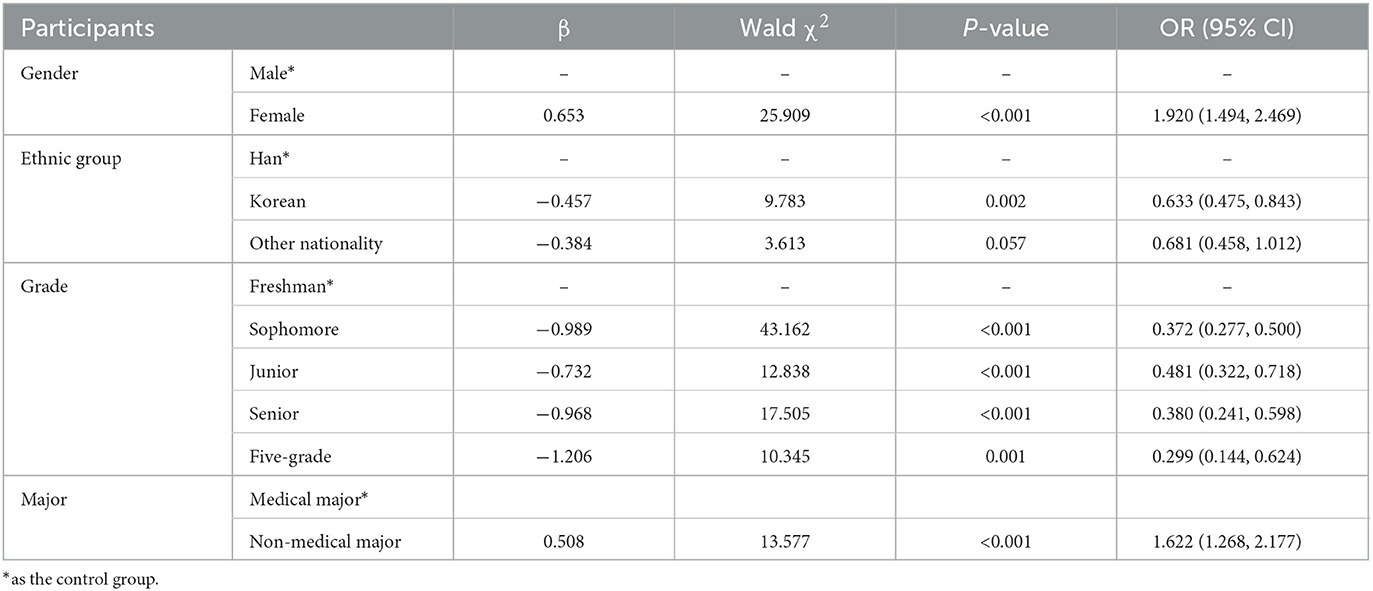
Table 7. Binary logistic regression analysis of influencing factors of college students' attitudes toward COVID-19 prevention and control.
College students' COVID-19 prevention and control practices
The average COVID-19 prevention and control practice score of college students was 20.48 ± 4.46. Most college students have taken the prevention and control measures in COVID-19. However, there are still many college students who have not taken preventive practice in using public chopsticks, exercising and keeping social distance (see Table 8).
The results of single factor analysis showed that there were significant differences in the scores of health practices for COVID-19 prevention and control among students with different urban and rural areas and grades (P < 0.05). More than half of the college students had good health behaviors, accounting for 53.48% of the sample (2818). Logistic regression analysis was further performed for the variables with statistical significance in the single factor analysis of practice scores. The results showed that, compared with freshmen, sophomores (OR = 0.601, 95% CI = 0.529–0.683), juniors (OR = 0.596, 95% CI = 0.501–0.709) and seniors (OR = 0.670, 95% CI = 0.542–0.828) were the risk factors for taken COVID-19 prevention and control behaviors. The results are shown in Tables 9, 10.

Table 10. Binary Logistic regression analysis of influencing factors for COVID-19 prevention and control practices.
Mental health status of college students during the COVID-19 pandemic
During the pandemic period, there were 2,398 college students (45.50%) with negative emotions. The results of single factor analysis showed that there were significant differences in the proportion of depression among college students of different sexes and with different grades, knowledge, attitudes and practices (P < 0.05). There were significant differences in the proportion of anxiety symptoms among college students of different nationalities and with different grades, knowledge, attitudes and practices (P < 0.05). There were significant differences in the proportion of stress emotions among students of different sexes and nationalities and with different grades, attitudes and practices (P < 0.05). In the single factor analysis of negative emotions, the variables with statistical significance were further analyzed by logistic regression, and the results were consistent with those of the single factor analysis.
Logistic results showed that females were the protective factor for depression (OR = 0.799, 95% CI = 0.701–0.911). Compared with freshmen, sophomores (OR = 1.776, 95% CI = 1.534–2.056), juniors (OR = 1.506, 95% CI = 1.237–1.834) and seniors (OR = 1.763, 95% CI = 1.394) are risk factors for depression. Positive attitudes (OR = 0.497, 95% CI = 0.384–0.643) and healthy behaviors (OR = 0.570, 95% CI = 0.502, 0.648) are the protective factors for depression. In terms of anxiety, compared with freshmen, sophomores (OR = 1.790, 95% CI = 1.569–2.042), juniors (OR = 1.760, 95% CI = 1.474–2.100) and seniors (OR = 1.890, 95% CI = 1.521–2.348) are risk factors. Compared with Han nationality, ethnic Korean nationality (OR = 1.171, 95% CI = 1.020–1.344) and other ethnic minorities (OR = 1.280, 95% CI = 1.061–1.544) are risk factors for anxiety. Positive cognition (OR = 0.737, 95% CI = 0.570–0.952) and adopting healthy behavior (OR = 0.567, 95% CI = 0.507–0.635) are protective factors. As for stress, females are the protective factors (OR = 0.688, 95% CI = 0.549–0.863). Compared with freshmen, sophomores (OR = 1.914, 95% CI = 1.471–2.489), juniors (OR = 1.599, 95% CI = 1.120–2.281) and seniors (OR = 2.535, 95% CI = 1.741) are risk factors. Compared with Han nationality, ethnic Korean nationality is a risk factor for stress (OR = 1.424, 95% CI = 1.098–1.848). Maintaining a positive attitude (OR = 0.312, 95% CI = 0.226–0.433) and healthy behavior (OR = 0.466, 95% CI = 0.369–0.590) are protective factors for stress (see Tables 11, 12 for details).
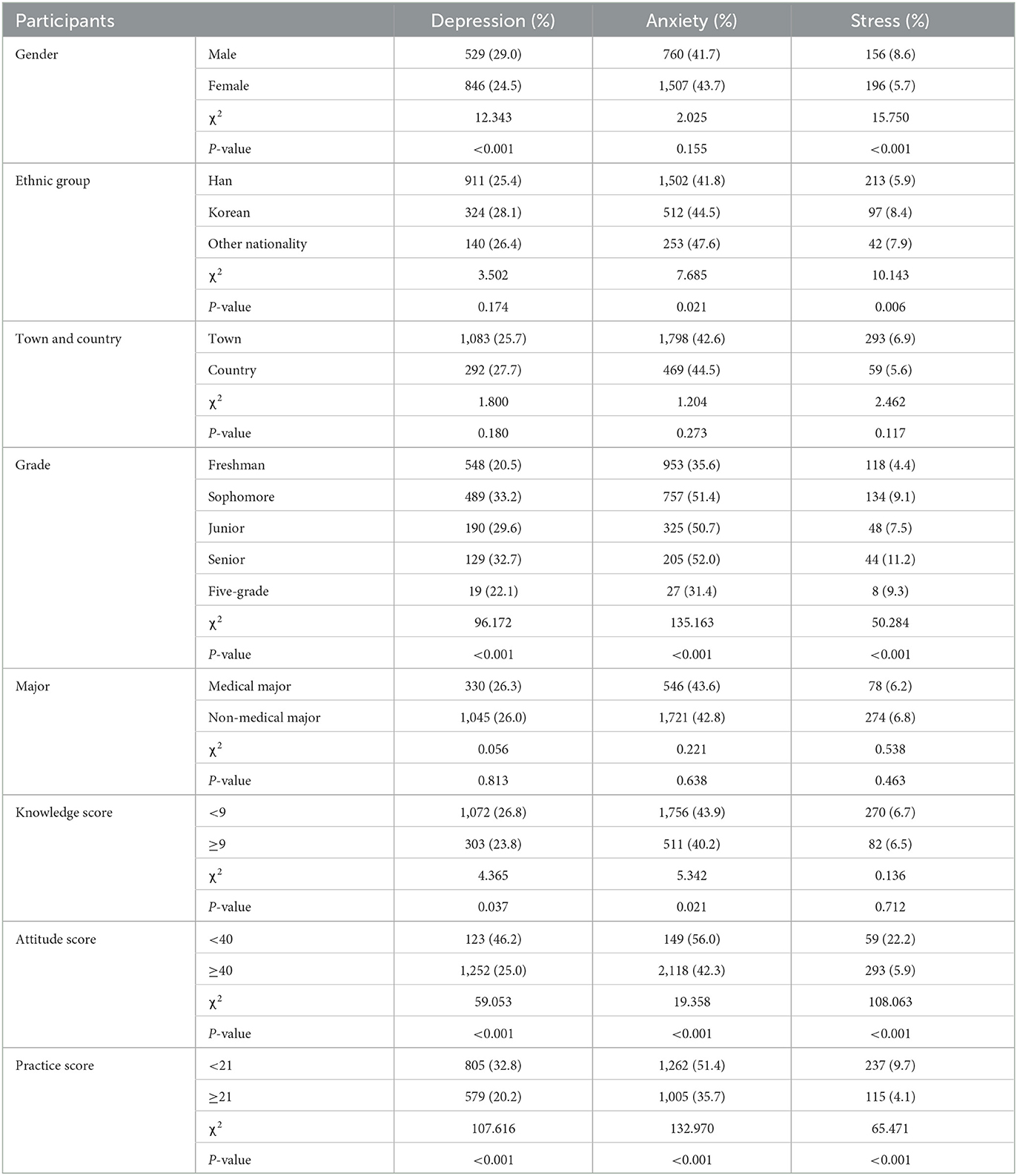
Table 11. Univariate analysis of depression, anxiety, and stress of college students with different characteristics.
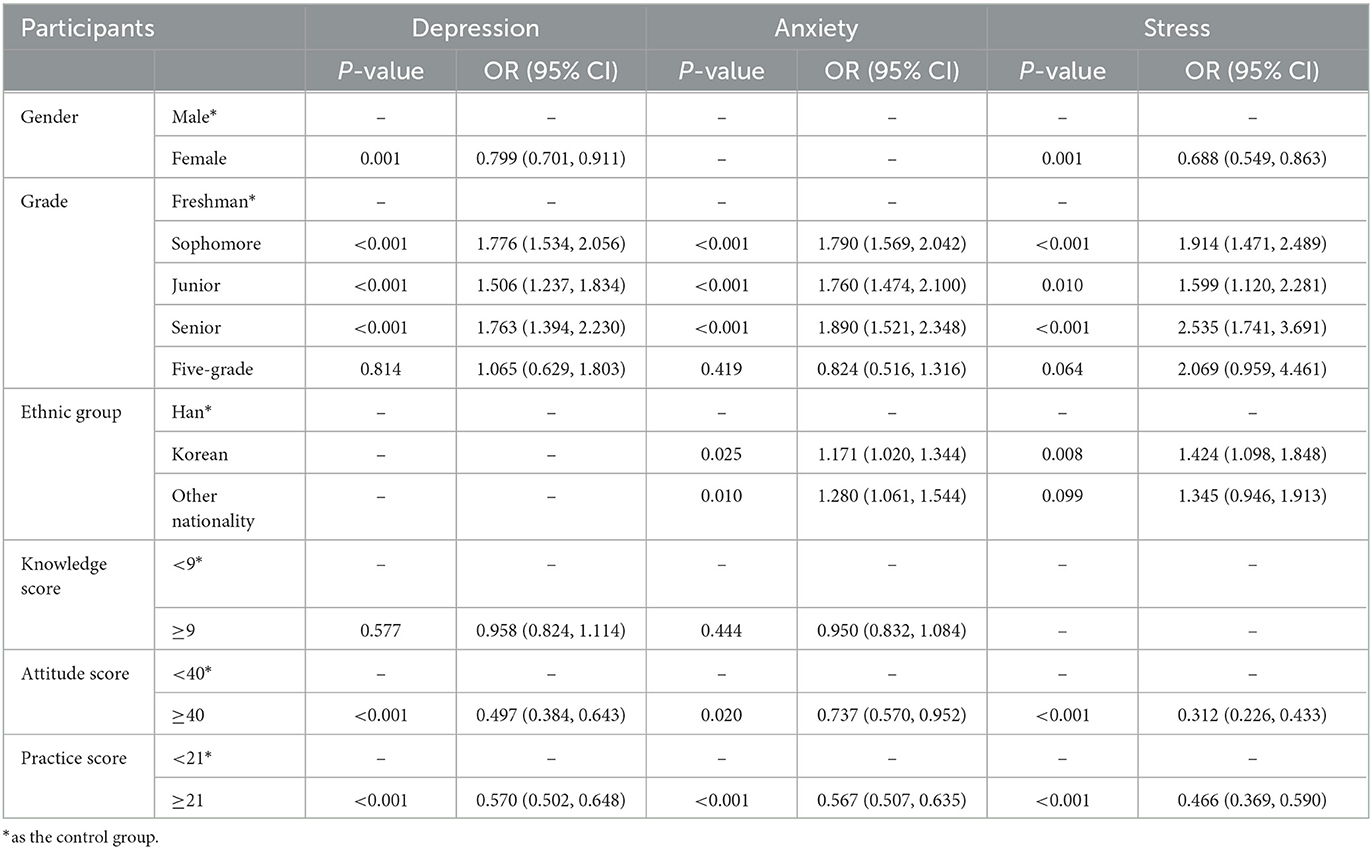
Table 12. Binary logistic regression analysis of influencing factors for college students' bad emotions.
Discussion
At present, the COVID-19 pandemic situation in China has been controlled, and it has entered the stage of normalized prevention and control (23). In addition to vaccines, strict preventive measures are the only other option to stop the rapid spread of diseases (24). Preventive measures play a vital role in reducing the infection rate of infectious diseases and controlling their spread, which suggests that it is necessary for the public to observe preventive measures, and the public's compliance with preventive measures is influenced by their KAP (25). Some studies have pointed out that people's KAP, as a part of public health emergency response capabilities, plays an important role in controlling the spread of COVID-19 (26). A large number of empirical studies have shown that health education can improve knowledge levels and change negative attitudes and behaviors, such as maintaining social distance, avoiding group gatherings and shaking hands, thus effectively curbing the spread of infectious diseases (27, 28). Empirical research on KAP can reveal basic information to determine the type of intervention to effectively control infectious diseases. Therefore, improving KAP is a potentially valuable strategy to gain better insight into misconceptions (29). Studies have found that in regard to health-related issues, college students can be a source of health awareness and health education because they are involved in spreading knowledge about the prevention and control of infectious diseases to the public for better tackling the ongoing pandemic (30, 31). In addition, a study found that social isolation and lockdowns due to the pandemic caused a series of mental health problems, such as stress, fear, anxiety, insomnia and emotional exhaustion (32). The evolution of the COVID-19 pandemic is uncertain and may have a long-term impact on mental health. College students with common mental health disorders are a vulnerable group. College students are in the delicate process of “transitioning” to adulthood and starting their careers, which makes them more prone to negative emotions (33). This study is helpful in bridging the gap in college students' knowledge, attitudes and behaviors regarding COVID-19 and improving their psychological states, which may reveal potential obstacles affecting changes in college students' social behavior.
Knowledge, attitudes and practices of college students regarding COVID-19
The results of this study showed that the COVID-19 knowledge awareness rate was low (24.11%). Most college students have poor knowledge of COVID-19 prevention and control and a poor understanding of COVID-19 infection. The reason for this phenomenon may be that pandemic information campaigns on the internet mainly focuses on personal protection and transmission, while less attention is given to related academic issues. As college students pay more attention to the prevention and control information and measures during the outbreak, they don't know enough about COVID-19's knowledge level, which leads to the poor awareness rate of COVID-19's related academic questions. The results show that most students are aware of the common symptoms of COVID-19, such as fever, cough and dyspnea, but they do not know enough about diarrhea and other symptoms. At present, most COVID-19 cases are asymptomatic infections. In Segen's medical dictionary, asymptomatic infections are defined as those lacking obvious clinical symptoms. An epidemiological investigation shows that the spread of asymptomatic infections of COVID-19, which means that the human body has almost no symptoms after infection, but it can be found that it has been infected through antibody testing, may lead to serious clinical diseases (34), suggesting that publicity and education regarding atypical symptoms should be strengthened through effective channels. It was found that college students have poor knowledge of the correct way to cover their noses and mouths when coughing and sneezing, which suggests that there are still some shortcomings regarding personal protection against COVID-19. With the continuous development of intelligent technology, network information is more and more concerned and relied on by people, and it is more and more deeply involved in people's daily life. While the Internet is becoming more and more prosperous, it is inevitable that the information is difficult to distinguish between true and false. It is found that one of the reasons for this phenomenon is that, driven by economic interests, some people who lack the awareness of public morality and the bottom line of laws and regulations, for their own interests (mainly economic interests), do not hesitate to create and spread false information and sensational news by online channels. There are also some online media participants who, with some bad motives, irresponsibly create rumors and attack and hurt today's society or individuals out of thin air. Therefore, the government official website, as the main channel for authoritative information sources, needs to expand its publicity to compensate for the lack of information validation for online social tools. In addition, the popularization of accurate COVID-19 knowledge should be strengthened in relevant school courses, and popular science of infectious disease prevention education should be provided. The research showed that the awareness rate of male students' health knowledge was lower than that of female students. The reason may be that female students pay more attention to social health problems, are more aware about preventive measures and have a higher knowledge acquisition ability than male students, which is consistent with related research results (35–39). Studies by Rana et al. (40) showed that there are significant differences in risk perception and coping mechanisms between the sexes. Compared with those of males, the risk perceptions of females increased by 2.26%, and their coping mechanisms increased by 3.41%. Therefore, accurate health education should be provided among college students, and attention should be given to boys. The results showed that the awareness rate of medical college students was higher than that of non-medical college students, which may be because medical students have corresponding medical professional knowledge, consistent with the results of other studies (41, 42). In addition, the knowledge awareness rate of fifth-year college students was high, which may be related to the fact that fifth-year college students are all medical students. It is suggested that health education should be strengthened for non-medical students.
The survey results showed that college students had a positive attitude and were supportive of the prevention and control of COVID-19, contributing to the prevention and control of COVID-19. An early set of studies on the attitudes and knowledge of COVID-19 found that people's attitudes toward the government's measures to curb the pandemic were highly correlated with their level of knowledge of COVID-19 (43). It was found that a higher level of information and education was related to a more positive attitude toward COVID-19 preventive measures. In this study, females had higher attitude scores than males. Studies have found that young men are more likely to express feelings of being invincible to COVID-19, so effective public health suggestions must be formulated for them (44). Non-medical majors had higher attitude scores than medical majors, suggesting that medical students may experience the phenomenon of separation of knowledge, attitudes and practice.
The results showed that more than half of college students had high health behaviors (53.48%). Among them, urban college students had higher scores than rural college students. This may be because of the better implementation of protective measures in cities and towns, the lack of access to information in rural areas, and the limited access to information resources such as computers or social media that can help students understand the latest situation of the COVID-19 pandemic, suggesting that the education of relevant students should be strengthened (45). Medical students should continue to improve their cognition and attitude level, which play an important role in self-prevention measures and passing on knowledge to family, friends or relatives to help fight against epidemic diseases (46). The effective implementation of prevention and control measures is fundamental to curbing the spread of the pandemic. It was found that respondents had high execution ability in wearing masks, but the rate of good behaviors such as physical exercise was not high. At present, the COVID-19 pandemic is still spreading to different degrees. It is necessary to strengthen vaccination initiatives and continue to promote the existing guidelines for limiting the spread of the virus, including physical isolation, wearing masks, regular hand washing and indoor ventilation.
KAP theory emphasizes that knowledge is the foundation of behavioral change, attitude is the driving force of behavioral change, and knowledge improves attitudes, thus leading to a positive attitude toward change behaviors (47). Knowledge is a prerequisite for promoting healthy behaviors and developing a positive attitude to fight diseases (48). Providing training on COVID-19 prevention methods and publicizing correct information about the new coronavirus pneumonia will help to improve cognition and attitudes toward the prevention and control of COVID-19, which are essential to promote good COVID-19 prevention and control (49). Therefore, universities should plan to strengthen health education programs for COVID-19 prevention to educate students to take relevant preventive measures, such as maintaining social distance and avoiding gatherings in densely populated areas, and strengthen relevant publicity and education in a targeted manner; as a result, college students could develop a more comprehensive understanding of COVID-19, which is especially critical for enhancing their prevention and control behaviors.
Interventions for college students' mental health should be considered
The research results showed that there were more boys than girls who had negative emotions. This may be related to the better awareness and attitudes of female college students regarding COVID-19. It was found that senior students had more obvious stress, anxiety and depression, which is similar to the results of the 2020 Chinese College Students' Health Survey Report. Logistics analysis of psychological status shows that ethnic Korean college students' scores of COVID-19's attitudes toward prevention and control are lower than those of Han college students, and ethnic Korean college students have more negative emotions than Han college students. It is suggested that lower levels of trust of ethnic Korean college students is the influencing factor of ethnic Korean college students' bad emotional status. In addition, in China, Chinese is the mother tongue for Han college students, while Chinese is the non-mother tongue for ethnic Korean college students, and ethnic Korean college students have poor understanding of knowledge. Therefore, compared with Han college students, ethnic Korean college students have lower levels of trust in prevention and control of COVID-19, and there are more negative emotional situations. The results suggest that schools should pay attention to the health education and psychological counseling of students in ethnic minority groups. In addition, the study found that a low KAP level was a risk factor for negative mood. The research subjects had a certain psychological burden in understanding the pandemic situation. Studies have found that college students may suffer more psychological troubles, such as stress and anger, due to isolation, school suspension, the prohibition of private gatherings and the reduction in learning efficiency due to online education, which leads to an increase in dangerous behaviors such as online gambling (50). As a public health emergency, the COVID-19 pandemic easily leads to individual psychological stress reactions, and stressful events are an important influencing factor of individual anxiety (51). In the era of high internet use, college students have strong insights into social problems, and when faced with stressful events, their emotional responses are more intense, and they are more likely to have problems such as depression, anxiety and stress (52). These results show that the mental health of college students cannot be ignored during the COVID-19 pandemic. Schools should instill a sense of social responsibility and community support in students, which may improve poor mental health outcomes. Colleges and universities should provide psychological counseling hotlines, and well-trained counselors and psychologists should provide free psychological intervention and counseling services through the Internet (53). Relevant school departments should provide scientific and effective publicity and psychological counseling, plan long-term psychological services to control and reduce the burden of psychological problems, and advocate for college students to increase physical exercise, develop good habits, and enhance their own resistance to formulate corresponding strategies and measures for prevention and control. In addition, schools should cooperate with government agencies and medical staff to conduct health promotion and information literacy projects to effectively improve the mental health level of college students (54). Considering that college students' psychological problems were previously widespread, COVID-19 will aggravate students' psychological problems, and the existing academic pressure and occupational pressure cannot be ignored. The results of this study can supplement information regarding the mental health status of college students in the COVID-19 period. In addition, the results of this study can also help to identify college students with increased risk of psychological problems. Universities can consider developing long-term psychological services, such as implementing KAP intervention measures regarding COVID-19, for these students to reduce their risk of psychological problems (55).
This research has some limitations. First, this study was limited to students in public universities, and online questionnaires were used. Not all college students in the whole school participated in this study. Therefore, the representativeness of the research results to all students is controversial. In addition, the data provided in this study were self-reported, so there may be recall bias. Due to the cross-sectional study design, the viewpoint may change, and this study is also unable to establish causality.
Conclusion
College students in minority areas have good health attitudes, but the awareness rate of COVID-19 prevention and control is low, the proportion of healthy behaviors is low, and negative emotions easily occur. It is suggested that schools and other departments adopt relevant KAP intervention strategies, further strengthen targeted publicity and education measures, and provide relevant psychological counseling to reduce the harm of the COVID-19 pandemic to health.
Data availability statement
The datasets presented in this article are not readily available to avoid misuse of data and information, the datasets used or analyzed during the current study are available from the corresponding author Y-HL on reasonable request. Requests to access the datasets should be directed to Y-HL, bGl5aWh1YUB5YnUuZWR1LmNu.
Ethics statement
The studies involving human participants were reviewed and approved by Institutional Review Board of Yanbian University (Ethical Code: 2021576, October 26th, 2021). Written informed consent for participation was not required for this study in accordance with the national legislation and the institutional requirements.
Author contributions
Conceptualization and formal analysis: TW, Y-HL, and Y-QL. Data curation, methodology, and writing—original draft: TW and Y-HL. Investigation: Y-HL, Z-HH, Y-SC, and Y-QL. Supervision and validation: Y-HL, Y-SC, and Z-HH. Writing—review and editing: Y-HL and Y-QL. All authors contributed to the article and approved the submitted version.
Funding
This research was funded by Department of Science and Technology of Jilin Province (No. L2020086), the Educational Science Research Project of Yanbian University in the 14th Five-Year Plan (No. GJ20211012), and the Postgraduate Education and Teaching Reform Research Project of Yanbian University (No. 2022YYXJ14).
Acknowledgments
The authors would like to thank Li Chengjie (Law College of Yanbian University), Liu Yanmei (Physical Education College of Yanbian University), and Zheng Yan (Student Affairs Department of Yanbian University) for their help in implementing the questionnaire survey. In addition, our gratitude goes to all the students of the general education course Public Health and Global Health.
Conflict of interest
The authors declare that the research was conducted in the absence of any commercial or financial relationships that could be construed as a potential conflict of interest.
Publisher's note
All claims expressed in this article are solely those of the authors and do not necessarily represent those of their affiliated organizations, or those of the publisher, the editors and the reviewers. Any product that may be evaluated in this article, or claim that may be made by its manufacturer, is not guaranteed or endorsed by the publisher.
References
1. Jiang ZH. Health literacy of college students on COVID-19 prevention and treatment. Chin Prev Med. (2022) 23:498–502. doi: 10.16506/j.1009-6639.2022.07.004
2. World Health Organization. WHO Coronavirus Disease(COVID-19)Dashboard. Available online at: https://covid19.who.int (accessed April 23, 2023).
3. Gao WJ, Wang B, Lu J, Yu CQ, Wang L, Li LM. Current status of COVID-19 pandemic and progress in response strategy. Chin J Epidemiol. (2021) 42:22–7. doi: 10.3760/cma.j.cn112338-20201026-01275
4. Araf Y, Akter F, Tang YD, Fatemi R, Parvez MSA, Zheng CF, et al. Omicron variant of SARS-CoV-2: genomics, transmissibility, and responses to current COVID-19 vaccines. J Med Virol. (2022) 94:1825–32. doi: 10.1002/jmv.27588
5. Luo YF, Chen LC, Yang SC, Hong S. Knowledge, attitude, and practice (KAP) toward COVID-19 pandemic among the public in Taiwan: a cross-sectional study. Int J Environ Res Public Health. (2022) 19:2784. doi: 10.3390/ijerph19052784
6. Nemat A, Raufi N, Sediqi MF, Rasib AR, Asady A. Knowledge, attitudes, and practices of medical students regarding COVID-19 in Afghanistan: a cross-sectional study. Risk Manag Healthc Policy. (2021) 14:1491–7. doi: 10.2147/RMHP.S308039
7. Noreen K, Zil-e-Rubab, Umar M, Rehman R, Baig M, Baig F. Knowledge, attitudes, and practices against the growing threat of COVID-19 among medical students of Pakistan. PLoS ONE. (2020) 15:e0243696. doi: 10.1371/journal.pone.0243696
8. Chai CS, Ng DLC, Chua WJ, Tung YZ, Sindeh W, Ibrahim MA, et al. Knowledge, attitude, and practices among the general population during the later stage of the COVID-19 pandemic in Malaysia: a cross-sectional study. Risk Manag Healthc Policy. (2022) 15:389–401. doi: 10.2147/RMHP.S349798
9. Ferdous MZ, Islam MS, Sikder MT, Mosaddek ASM, Zegarra-Valdivia JA, Gozal D. Knowledge, attitude, and practice regarding COVID-19 outbreak in Bangladesh: an online-based cross-sectional study. PLoS ONE. (2020) 15:e0239254. doi: 10.1371/journal.pone.0239254
10. Fan ZY, Mou YL, Cheng R, Zhao Y, Zhang F. Investigation of knowledge, attitude and practice of personal protection among different types of workers returning to work under COVID-19 epidemic. Front Public Health. (2021) 9:679699. doi: 10.3389/fpubh.2021.679699
11. Zhang X. Perpectual challenges of emerging infectious disease of school children. Chin J Sch Health. (2020) 24:641–4. doi: 10.16835/j.cnki.1000-9817.2020.05.001
12. Singh PK, Anvikar A, Sinha A. COVID-19 related knowledge, attitudes, and practices in Indian population: an online national cross-sectional survey. PLoS ONE. (2022) 17:e0264752. doi: 10.1371/journal.pone.0264752
13. Aynalem YA, Akalu TY, Gebregiorgis BG, Sharew NT, Assefa HK, Shiferaw WS. Assessment of undergraduate student knowledge, attitude, and practices towards COVID-19 in Debre Berhan University, Ethiopia. PLoS ONE. (2021) 16:e0250444. doi: 10.1371/journal.pone.0250444
14. Ma SY, Chen Y, Wang FF, Wang HH, Jin YL, Yao YS. Anxiety of medical students during the epidemic in COVID-19 and its influencing factors. Chin J Sch Health. (2021) 42:1351–5. doi: 10.16835/j.cnki.1000-9817.2021.09.018
15. Wang DD, Zhang L, Liu JZ, Wu XP. Characteristics and relationship between college students' self-efficacy and physical activity during the COVID-19 epidemic. Chin J Sch Health. (2021) 42:697–701. doi: 10.16835/j.cnki.1000-9817.2021.05.014
16. Hoyt LT, Cohen AK, Dull B, Castro EM, Yazdani N. “Constant stress has become the new normal”: stress and anxiety inequalities among US college students in the time of COVID-19. J Adolesc Health. (2021) 68:270–6. doi: 10.1016/j.jadohealth.2020.10.030
17. Zhang JX, Yin YH, Dean J, Zhang XL, Zhang YY, Wang JC, et al. Knowledge, attitude, and practice survey of COVID-19 among healthcare students during the COVID-19 outbreak in China: an online cross-sectional survey. Front Public Health. (2021) 9:742314. doi: 10.3389/fpubh.2021.742314
18. Rias YA, Rosyad YS, Chipojola R, Wiratama BS, Safitri CI, Weng SF, et al. Effects of spirituality, knowledge, attitudes, and practices toward anxiety regarding COVID-19 among the general population in Indonesia: a cross-sectional study. J Clin Med. (2020) 9:3798. doi: 10.3390/jcm9123798
19. Graupensperger S, Benson AJ, Kilmer JR, Evans MB. Social (un)distancing: teammate interactions, athletic identity, and mental health of student-athletes during the COVID-19 pandemic. J Adolesc Health. (2020) 67:662–70. doi: 10.1016/j.jadohealth.2020.08.001
20. Jia YH, Ma SL, Bai LJ, Xiao Q, Wu Y, Gao Y, et al. Health literacy and disparities in knowledge, attitude and practice regarding COVID-19 among college students during the COVID-19 outbreak in China: a cross-sectional study. Risk Manag Healthc Policy. (2021) 14:4477–88. doi: 10.2147/RMHP.S319331
21. Chen X. Guide to Prevention and Control of novel coronavirus in Colleges and Universities. Beijing: People's Medical Publishing House (2020).
22. Bi PF, Luo P, An L. Investigation on mental health status of medical college students under COVID-19 epidemic. J Jinzhou Med Univ. (2021) 19:77–81. doi: 10.13847/j.cnki.lnmu(sse).2021.02.020
23. Qin SR, Zhou MQ, Ding Y. Risk perception measurement and influencing factors of COVID-19 in medical college students. Front Public Health. (2021) 9:774572. doi: 10.3389/fpubh.2021.774572
24. Raza S, Mukhtar N, Nawaz M, Ali MA, Shabbir MAB, Ashraf MA, et al. A cross-sectional survey of knowledge, attitude, and practices of university students in Pakistan regarding COVID-19. Front Public Health. (2021) 9:697686. doi: 10.3389/fpubh.2021.697686
25. Hatabu A, Mao XH, Zhou Y, Kawashita N, Wen Z, Ueda M, et al. Knowledge, attitudes, and practices toward COVID-19 among university students in Japan and associated factors: an online cross-sectional survey. PLoS ONE. (2020) 15:e0244350. doi: 10.1371/journal.pone.0244350
26. Lu JT, Guo XQ, Han XY, Deng B, Zhao Q, Zhao G, et al. The knowledge, attitude and practice about public emergencies and the response capability of residents in Shanghai after the outbreak of coronavirus disease 2019 (COVID-19): a cross-sectional study. Int J Environ Res Public Health. (2021) 18:4814. doi: 10.3390/ijerph18094814
27. Xu N, Zhang YA, Zhang XN, Zhang GW, Guo ZK, Zhao N, et al. Knowledge, attitudes, and practices of urban residents toward COVID-19 in Shaanxi during the post-lockdown period. Front Public Health. (2021) 9:659797. doi: 10.3389/fpubh.2021.659797
28. Dorji T, Wangmo K, Yezer, Wangchuk T, Tshokey, Wangdi K. Knowledge, attitude, and practice toward COVID-19 among Sherubtse college students in Bhutan: a web-based cross-sectional study. Front Public Health. (2021) 9:721493. doi: 10.3389/fpubh.2021.721493
29. Honarvar B, Lankarani KB, Kharmandar A, Shaygani F, Zahedroozgar M, Haghighi MRR, et al. Knowledge, attitudes, risk perceptions, and practices of adults toward COVID-19: a population and field-based study from Iran. Int J Public Health. (2020) 65:731–9. doi: 10.1007/s00038-020-01406-2
30. Sirat R, Sahrai MS, Rahimi BA, Asady A, Wasiq AW. Knowledge, attitudes and practices of university students toward COVID-19 in Southern region, Afghanistan: a cross-sectional study. BMC Med Educ. (2023) 23:171. doi: 10.1186/s12909-023-04164-w
31. Baniyas N, Sheek-Hussein M, Kaabi NA, Shamsi MA, Neyadi MA, Khoori RA, et al. COVID-19 knowledge, attitudes, and practices of United Arab Emirates medical and health sciences students: a cross sectional study. PLoS ONE. (2021) 16:e0246226. doi: 10.1371/journal.pone.0246226
32. Syed AA, Gupta S, Rai D. Psychological, social and economic impact of COVID 19 on the working population of India: exploratory factor analysis approach. Int J Disaster Risk Reduct. (2021) 66:102617. doi: 10.1016/j.ijdrr.2021.102617
33. Villani L, Pastorino R, Molinari E, Anelli F, Ricciardi W, Graffigna G, et al. Impact of the COVID-19 pandemic on psychological well-being of students in an Italian university: a web-based cross-sectional survey. Global Health. (2021) 17:39. doi: 10.1186/s12992-021-00680-w
34. Geng JP, Yu J, Lu T, Wang YH, Cao Y. A silent infection pandemic of COVID-19: epidemiological investigation and hypothetical models. Can J Infect Dis Med Microbiol. (2020) 2020:5120253. doi: 10.1155/2020/5120253
35. Lu XF, Zhou PZ, Ma H, Wang WJ, Sun HY. KAP survey for COVID-19 among university students and its influencing factors. J Jining Med Univ. (2021) 44:107–10. doi: 10.3969/j.issn.1000-9760.2021.02.008
36. Wei YY. Research on Personal Knowledge Management Ability of University Students on the Theory of Cognition. (Master's thesis). Wuhan University, Wuhan (2017).
37. Liu D, Chen PL, Li ZH, Wang ZH, Shen D, Zhang YJ, et al. The status of knowledge, attitude and practice about coronavirus disease 2019 epidemic among university students and its influencing factors. Chin J Dis Control Prev. (2020) 24:501–5. doi: 10.16462/j.cnki.zhjbkz.2020.05.002
38. Qutob N, Awartani F. Knowledge, attitudes and practices (KAP) towards COVID-19 among Palestinians during the COVID-19 outbreak: a cross-sectional survey. PLoS ONE. (2021) 16:e0244925. doi: 10.1371/journal.pone.0244925
39. Muslih M, Susanti HD, Rias YA, Chung MH. Knowledge, attitude, and practice of indonesian residents toward COVID-19: a cross-sectional survey. Int J Environ Res Public Health. (2021) 18:4473. doi: 10.3390/ijerph18094473
40. Rana IA, Bhatti SS, Aslam AB, Jamshed A, Ahmad J, Shah AA. COVID-19 risk perception and coping mechanisms: does gender make a difference? Int J Disaster Risk Reduct. (2021) 55:102096. doi: 10.1016/j.ijdrr.2021.102096
41. Zhao N, Dai RJ, Zhang HL, Yue J, Pei LY, Wu R, et al. Investigation and analysis of college students' demand for knowledge, belief and behavior in novel coronavirus and after returning to school. South China J Prev Med. (2021) 47:327–31.
42. Angelo AT, Alemayehu DS, Dacho AM. Knowledge, attitudes, and practices toward Covid-19 and associated factors among university students in Mizan Tepi University, 2020. Infect Drug Resist. (2021) 14:349–60. doi: 10.2147/IDR.S299576
43. Zhong BL, Luo W, Li HM, Zhang QQ, Liu XG, Li WT, et al. Knowledge, attitudes, and practices towards COVID-19 among Chinese residents during the rapid rise period of the COVID-19 outbreak: a quick online cross-sectional survey. Int J Biol Sci. (2020) 16:1745–52. doi: 10.7150/ijbs.45221
44. Bates BR, Tami A, Carvajal A, Grijalva MJ. Knowledge, attitudes, and practices towards COVID-19 among Venezuelans during the 2020 epidemic: an online cross-sectional survey. PLoS ONE. (2021) 16:e0249022. doi: 10.1371/journal.pone.0249022
45. Feleke BT, Wale MZ, Yirsaw MT. Knowledge, attitude and preventive practice towards COVID-19 and associated factors among outpatient service visitors at Debre Markos compressive specialized hospital, north-west Ethiopia, 2020. PLoS ONE. (2021) 16:e0251708. doi: 10.1371/journal.pone.0251708
46. An PL, Huynh G, Nguyen HTN, Pham BDU, Nguyen VT, Tran TTT, et al. Knowledge, attitude, and practice towards COVID-19 among healthcare students in Vietnam. Infect Drug Resist. (2021) 14:3405–13. doi: 10.2147/IDR.S328677
47. Huang ZP, Huang MX, Zhang KT, Ding CX, Li TY, Huang PK, et al. Knowledge, attitude and practice about the prevention and control of COVID-19 in middle school students and their mental health. J Shantou Univ Med College. (2021) 34:109–13. doi: 10.13401/j.cnki.jsumc.2021.02.011
48. Limbu DK, Piryani RM, Sunny AK. Healthcare workers' knowledge, attitude and practices during the COVID-19 pandemic response in a tertiary care hospital of Nepal. PLoS ONE. (2020) 15:e0242126. doi: 10.1371/journal.pone.0242126
49. Belete ZW, Berihun G, Keleb A, Ademas A, Berhanu L, Abebe M, et al. Knowledge, attitude, and preventive practices towards COVID-19 and associated factors among adult hospital visitors in South Gondar Zone Hospitals, Northwest Ethiopia. PLoS ONE. (2021) 16:e0250145. doi: 10.1371/journal.pone.0250145
50. Yoon S, Baek YJ, Kim JW. A review of empirical studies of college students' mental health during COVID-19 pandemic. Local Global Korean J Soc Sci. (2021) 45:249–86. doi: 10.33071/ssricb.45.3.202109.249
51. Michl LC, Mclaughlin KA, Shephe K, Nolen-Hoeksema S. Rumination as a mechanism linking stressful life events to symptoms of depression and anxiety: longitudinal evidence in early adolescents and adults. J Abnorm Psychol. (2013) 122:339. doi: 10.1037/a0031994
52. Jin YL, Chang WW, Chang X, Zhu LJ, Fang ZM, Chen Y, et al. Analysis of mental health and influencing factors of college students in the online learning period during the outbreak of COVID-19. Chin J Sch Health. (2021) 42:574–8. doi: 10.16835/j.cnki.1000-9817.2021.04.022
53. Sharma V, Ortiz MR, Sharma N. Risk and protective factors for adolescent and young adult mental health within the context of COVID-19: a perspective from Nepal. J Adolesc Health. (2020) 67:135–7. doi: 10.1016/j.jadohealth.2020.04.006
54. Superio DL, Anderson KL, Oducado RMF, Luceño MT, Palcullo VEV, Bendalian MVT. The information-seeking behavior and levels of knowledge, precaution, and fear of college students in Iloilo, Philippines amidst the COVID-19 pandemic. Int J Disaster Risk Reduct. (2021) 62:102414. doi: 10.1016/j.ijdrr.2021.102414
Keywords: knowledge, attitudes, practices, COVID-19, mental health
Citation: Li Y-H, Wen T, Cui Y-S, Huang Z-H and Liu Y-Q (2023) Knowledge, attitudes, and practices regarding COVID-19 and mental health status among college students in China: a cross-sectional study. Front. Public Health 11:1157862. doi: 10.3389/fpubh.2023.1157862
Received: 03 February 2023; Accepted: 12 June 2023;
Published: 28 June 2023.
Edited by:
Sukhyun Ryu, Konyang University, Republic of KoreaReviewed by:
Zisis Kozlakidis, International Agency for Research on Cancer (IARC), FranceMuhammad Mainuddin Patwary, Environment and Sustainability Research Initiative, Bangladesh
Copyright © 2023 Li, Wen, Cui, Huang and Liu. This is an open-access article distributed under the terms of the Creative Commons Attribution License (CC BY). The use, distribution or reproduction in other forums is permitted, provided the original author(s) and the copyright owner(s) are credited and that the original publication in this journal is cited, in accordance with accepted academic practice. No use, distribution or reproduction is permitted which does not comply with these terms.
*Correspondence: Yan-Qun Liu, MTM4NDQzMTI4MTZAMTYzLmNvbQ==
 Yi-Hua Li
Yi-Hua Li Tao Wen
Tao Wen Yin-Shi Cui2
Yin-Shi Cui2